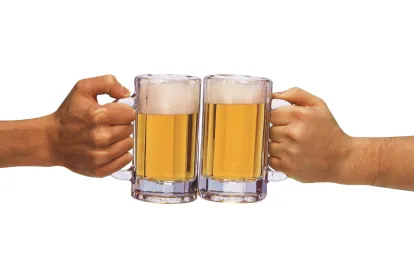In CREW Republic Brewery GmbH v Office for Harmonisation in the Internal Market (OHIM) (Case R167/2015-4), the Fourth Board of Appeal of OHIM has found that the registration of the word mark DETOX as a Community trademark (CTM) for “beers” in Class 32 is eligible for registration because its meaning is neither descriptive, nor does it lack distinctiveness, nor is it deceptive.
 On August 22, 2014 the applicant sought to register the word mark DETOX in Class 32 covering “beers”. During examination, the examiner refused the application on the legal grounds of Article 7(1)(b), (c) and (g) of the Community Trademark Regulation (207/2009). The examiner argued that the English word DETOX means “detoxify (the body)”. Thus, the mark describes the nature of the goods to the extent that they serve the detoxification of the body by drinking non-alcoholic beers. As a consequence of its descriptiveness, the mark DETOX is not distinctive. The examiner further argued that with regard to alcoholic beers, which are not suitable for detoxification, the mark is even deceptive.
On August 22, 2014 the applicant sought to register the word mark DETOX in Class 32 covering “beers”. During examination, the examiner refused the application on the legal grounds of Article 7(1)(b), (c) and (g) of the Community Trademark Regulation (207/2009). The examiner argued that the English word DETOX means “detoxify (the body)”. Thus, the mark describes the nature of the goods to the extent that they serve the detoxification of the body by drinking non-alcoholic beers. As a consequence of its descriptiveness, the mark DETOX is not distinctive. The examiner further argued that with regard to alcoholic beers, which are not suitable for detoxification, the mark is even deceptive.
The applicant appealed this decision arguing that the term DETOX is clearly meant to be satirical and ironical in the context of the applied goods, especially since beers are normally offered in beverage markets, not drugstores or rehab clinics. Neither non-alcoholic beers nor those with minimal alcohol content are used for therapeutic purposes. Based on a realistic view, the mark cannot be deceptive either. It is not the word DETOX that suggests only non-alcoholic beers are sold under this designation; rather it is the applicable food regulations and labelling on the beer bottle which supply the relevant information.
The Board of Appeal found that there is no evidence to justify the examiner’s conclusion that beers are suitable for detoxifying the body and can be used accordingly. It further stated that even the examiner itself did not elaborate on this point. Beer is neither known to the relevant public as a household remedy against poisoning, nor is it sold in drugstores, health food stores or pharmacies as a resource available for healthcare. Detoxification generally means a reduction of toxicity in the body, i.e. a process is set in motion leading to the removal of toxins. It is unclear in what manner the consumption of beer, whether alcoholic or not, could cause such a detoxification of the body. Therefore, there is no factual link between the term DETOX and “beers” which could lead the consumers to believe that the word DETOX is an indicator of a characteristic of “beers”. Thus, the rejection of the application based on Article 7 (1)(c) CTMR was unfounded.
The legal ground under Article 7 (1)(b) CTMR is equally unavailable because the finding of a lack of distinctive character solely derives from the erroneously assumed descriptive character of the mark.
Lastly, the Board of Appeal found that a risk of deception as required under Article 7 (1)(g) CTMR does not exist in the present case. The consumers very well know that beer is usually alcoholic and the consumption of alcohol does not detoxify the body. Even if it were to assume that the alcoholic content of beers varies, a deception about is antioxidant characteristic must be excluded based on the comprehensive consumer knowledge about the effects of drinking beer.
Consequently, the Board of Appeal found that the trademark may proceed to registration.
The present case is a good example for the legal assessment of whether a sign is descriptive or not under Article 7(1)(c). Such assessment must be made, first, in relation to the goods or services for which the sign has been applied and, second, in relation to the perception of the target public, which is composed of the consumers of those applied goods or services.
The Germans have always been recognized as notorious beer brewers, especially because they are required under the “German Beer Purity Law” to limit a brew’s ingredients to only barley, hops, water, and yeast. In addition to the mainstream brewers, the country is now seeing a growing number of craft beer breweries, including the applicant, who is located in Munich, the city which is best known among beer connoisseurs for Oktoberfest. This brewery offers at least seven variations of IPA, one of which is the hoppy and malty “DETOX session ale”.
From a trademark perspective, the generic term IPA itself, apart from being a generic term for a certain type of beer, is just as interesting as DETOX. The abbreviation IPA generally stands for “India Pale Ale”, “Pale Ale as prepared for India”, “India Ale”, “Pale India Ale”, or “Pale export India Ale”. The reference to “India” could then cause the confusion that it may serve to designate the geographical origin of the beer production, when, in fact, it is an important reference to the history of IPAs.
At the height of the British Empire, the British had thousands of emigrants, with India being one of its most important outposts. The demand for beer was high, but beer did not keep well on long ocean voyages, and India itself was too warm for brewing. The solution to this problem during the 18th and 19th centuries was the export of IPAs, which did not turn into flat, sour beer during the several month lasting voyages because it was brewed with an extra amount of hops, which allowed for longer storage.




 />i
/>i

